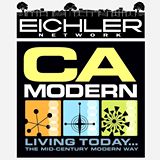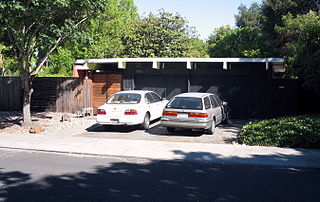
San Mateo is a city in San Mateo County, California, about 20 miles (32 km) south of San Francisco, and 31 miles (50 km) northwest of San Jose. San Mateo had an estimated 2019 population of 104,430. It has a Mediterranean climate, and is known for its rich history. The biggest economic contributors to the city include the Medical Center, one of the local school districts, and Sony's Sony Interactive Entertainment division. Finally, being in the center of the San Francisco Bay Area, it has many ways to travel beween the major cities of that area.

The Hermitage is a historical plantation and museum located in Davidson County, Tennessee, United States, 10 miles (16 km) east of downtown Nashville. The 1,000 acre, self-sustaining plantation relied completely on the labor of enslaved African American men, women and children and was owned by Andrew Jackson, the seventh President of the United States, from 1804 until his death at the Hermitage in 1845. It also serves as his final resting place. Jackson only lived at the property occasionally until he retired from public life in 1837. It is a National Historic Landmark.

Archibald Quincy Jones was a Los Angeles-based architect and educator known for innovative buildings in the modernist style and for urban planning that pioneered the use of greenbelts and green design.

Mid-century modern (MCM) is an American design movement in interior, product, graphic design, architecture, and urban development that was popular from roughly 1945 to 1969, during the United States's post–World War II period. The term was used descriptively as early as the mid-1950s, and defined as a design movement by Cara Greenberg in her 1984 book, Mid-Century Modern: Furniture of the 1950s. It is now recognized by scholars and museums worldwide as a significant design movement. The MCM design aesthetic is modern in style and construction, aligned with the Modernism movement of the period. It is typically characterized by clean, simple lines, honest use of materials, and it generally does not include decorative embellishments.

Joseph Leopold Eichler was a 20th-century post-war American real estate developer known for developing distinctive residential subdivisions of Mid-century modern style tract housing in California. He was one of the influential advocates of bringing modern architecture from custom residences and large corporate buildings to general public availability. His company and developments remain in the Greater San Francisco Bay Area and Greater Los Angeles.

Raphael S. Soriano, FAIA, was an architect and educator, who helped define a period of 20th-century architecture that came to be known as Mid-century modern. He pioneered the use of modular prefabricated steel and aluminum structures in residential and commercial design and construction.
The Highlands is a neighborhood and unincorporated district in San Mateo County, California, United States. It is bordered by Interstate 280 to the west, State Route 92 to the south, Polhemus Road to the east, and Crystal Springs Road, which parallels San Mateo Creek, to the north. The town of Hillsborough is just north of the Highlands and the city of Belmont is to the south.

Lipetz House is a house in Los Angeles designed by Raphael Soriano, and built in 1936.

The Adamson House and its associated land, which was known as Vaquero Hill in the nineteenth century, is a historic house and gardens in Malibu, California. The residence and estate is on the coast, within Malibu Lagoon State Beach park.

The Maynard Buehler House in Orinda, California is a 4,000 square feet Usonian home designed by Frank Lloyd Wright in 1948 for Katherine Z. "Katie" and Maynard P. Buehler. Since 2016 the house has been used as a venue for weddings, after being featured in Vogue magazine.

The Bailey House, or Case Study House #21, is a steel-framed modernist house in the Hollywood Hills, designed by Pierre Koenig. It was registered as Los Angeles Historic-Cultural Monument #669, with the endorsement of then-owner Michael LaFetra, the Los Angeles Conservancy, and Pierre and Gloria Koenig.
CA-Modern is an American magazine devoted to mid-century modern architecture and design in California. It is published by the Eichler Network, a company based in San Francisco that also operates a website and sends weekly e-mail news features to subscribers. It also publishes a service directory of firms that specialize in repair and improvement of mid-century modern homes, including those built from the 1950s to 1970s by Bay Area developer Joe Eichler of Eichler Homes, Inc.

The Eichler Network is an American company that produces the quarterly CA-Modern print magazine, a website, and weekly email news articles about mid-century modern (MCM) architecture and design in California. It also publishes a directory of contractors and other service providers who focus on modern home preservation and improvement. Both the Eichler Network and CA-Modern were founded by Marty Arbunich, first as the quarterly Eichler Network print newsletter in 1993, then as the 36-page, full-color magazine since 2006.

The Birthplace of Simón Bolívar is a seventeenth-century house in the Venezuelan capital city Caracas where the hero of Venezuelan and Latin American independence, Simón Bolívar, was born. Now a significant tourist attraction, the building is located in a little street off the Plaza San Jacinto, a block east of the Plaza Bolívar. It is one of only a few houses from the colonial era which survive in central Caracas.

Meems Bottom Covered Bridge is a covered bridge in Shenandoah County, Virginia, United States. The bridge, at 204 feet (62 m), is the longest covered bridge in Virginia and one of the last that supports regular traffic. Near the town of Mount Jackson, the Meems Bottom Covered Bridge features a 200-foot single-span wooden Burr arch structure. Built in 1892 by Franklin Hiser Wissler, the wooden bridge over the North Fork of the Shenandoah River provided access to his apple orchards at Strathmore Farms. The bridge was listed on the National Register of Historic Places on June 10, 1975.

Greenmeadow is a subdivision located in southern Palo Alto, California.
Robert Rummer was a post-war U.S. American real estate developer best known for developing distinctive residential subdivisions of Mid-Century modern style tract housing in Oregon, United States.
Frederick Earl Emmons was an American architect. With A. Quincy Jones, he designed many residential properties, including tract houses developed by Joseph Eichler in the Pacific Palisades, Orange, Palo Alto, San Rafael, and commercial buildings in Palm Springs, Pomona, Whittier and Los Angeles. They also designed the Charles E. Young Research Library on the campus of the University of California, Los Angeles (UCLA).
John Calder Mackay was an American post-war real estate developer, best known for his modernist tract homes built by the company he co-founded, Mackay Homes. He also served on the board of directors for the Children's Health Council and was one of the founders of the Palo Alto Medical Foundation.

150 Nassau Street, also known as the Park Place Tower and the American Tract Society Building, is a 23-story, 291-foot (89 m) building in the Financial District of Lower Manhattan in New York City. It is located at the southeast corner of Spruce Street and Nassau Street, next to 8 Spruce Street, the former New York Times Building, and New York City Hall.















